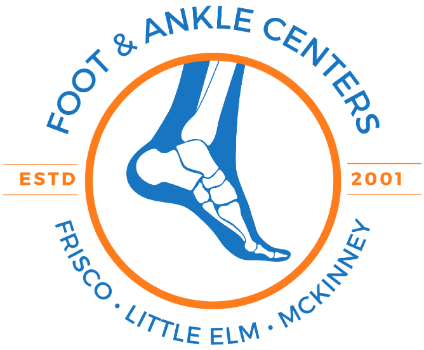Understanding Ankle Sprains: Causes, Symptoms, and Treatment Options
Ankle sprains are a common injury that can occur in various situations, from everyday activities to sports. At the Foot & Ankle Centers of Frisco, Little Elm, and McKinney, we understand the impact that an ankle sprain can have on your daily life and overall mobility. In this blog post, we’ll explore the causes of ankle sprains, how to recognize the symptoms, and the most effective treatment options to help you recover quickly and get back on your feet.
What Is an Ankle Sprain?
An ankle sprain occurs when the ligaments that support the ankle are stretched or torn. Ligaments are strong bands of connective tissue that stabilize joints and prevent excessive movement. When the ankle is twisted, rolled, or turned beyond its normal range of motion, these ligaments can be damaged, leading to a sprain.
Causes of Ankle Sprains
Ankle sprains can result from various activities or situations, including:
- Sports Injuries: High-impact sports such as basketball, soccer, and running often involve quick direction changes, jumps, and landings that can lead to ankle sprains.
- Improper Footwear: Wearing shoes that do not provide adequate support or have poor traction can increase the risk of ankle injuries.
- Uneven Surfaces: Walking or running on uneven terrain or surfaces can cause the ankle to twist or roll, leading to a sprain.
- Accidents: Slips, trips, or falls can also result in ankle sprains, especially if the foot lands awkwardly or the ankle is subjected to sudden force.
Symptoms of Ankle Sprains
Recognizing the symptoms of an ankle sprain is crucial for prompt treatment. Common symptoms include:
- Pain: Pain around the ankle, which may range from mild to severe, depending on the extent of the sprain.
- Swelling: Swelling around the ankle joint is a common sign of a sprain and can vary in severity.
- Bruising: Discoloration or bruising around the ankle may occur as a result of blood vessels being damaged.
- Stiffness: Reduced range of motion and stiffness in the ankle joint can make it difficult to move or bear weight.
- Tenderness: The affected area may be tender to the touch, particularly along the ligament and joint lines.
Grades of Ankle Sprains
Ankle sprains are classified into three grades based on the severity of the ligament damage:
- Grade I (Mild): Minor stretching or tearing of the ligament with minimal swelling and pain. Typically, patients can walk with some discomfort.
- Grade II (Moderate): Partial tear of the ligament with moderate pain, swelling, and bruising. Walking is often difficult without support.
- Grade III (Severe): Complete tear or rupture of the ligament with severe pain, significant swelling, and inability to bear weight. Immediate medical attention is usually required.
Diagnosis of Ankle Sprains
To diagnose an ankle sprain, a podiatrist will conduct a thorough evaluation, including:
- Medical History: Discussing the circumstances of the injury and any previous ankle problems.
- Physical Examination: Assessing the ankle for swelling, bruising, and tenderness, and evaluating the range of motion.
- Imaging Tests: X-rays or other imaging tests may be performed to rule out fractures and determine the extent of ligament damage.
Treatment Options for Ankle Sprains
The treatment for an ankle sprain depends on the severity of the injury. Here are common treatment approaches:
1. Initial Care (R.I.C.E. Method)
For most ankle sprains, initial care involves the R.I.C.E. method:
- Rest: Avoid putting weight on the injured ankle and rest to prevent further damage.
- Ice: Apply ice to the affected area for 15-20 minutes every 2-3 hours to reduce swelling and pain.
- Compression: Use an elastic bandage or wrap to provide compression and support to the ankle.
- Elevation: Elevate the ankle above the level of your heart to minimize swelling.
2. Pain Management
Over-the-counter pain relievers, such as ibuprofen or acetaminophen, can help manage pain and inflammation.
3. Rehabilitation and Physical Therapy
Once the acute phase has passed, physical therapy may be recommended to restore strength, flexibility, and range of motion. Exercises may include:
- Range of Motion Exercises: Gentle movements to improve flexibility and reduce stiffness.
- Strengthening Exercises: Targeted exercises to strengthen the muscles around the ankle and improve stability.
- Balance Training: Activities to enhance proprioception and prevent future injuries.
4. Supportive Devices
Depending on the severity of the sprain, your podiatrist may recommend the use of ankle braces or splints to provide additional support and prevent further injury.
5. Surgical Intervention
In rare cases of severe sprains with significant ligament damage or persistent instability, surgical intervention may be necessary to repair the torn ligaments.
Preventing Ankle Sprains
To reduce the risk of future ankle sprains:
- Wear Proper Footwear: Choose shoes with good support and traction suitable for your activity.
- Strengthen Your Ankles: Incorporate exercises to build strength and stability in your ankles and lower legs.
- Be Cautious on Uneven Surfaces: Pay attention to where you walk, and be mindful of uneven terrain.
- Warm Up and Stretch: Always warm up before physical activity and include ankle stretches in your routine.


Leave a comment
0 Comments